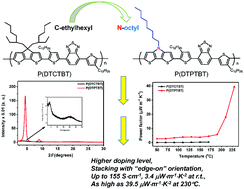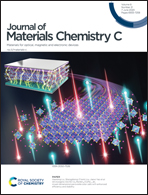Enhancement of the thermoelectric performance for DTC-based polymer via N-octyl substitution†
Abstract
Focusing on the impact of carrier concentration and mobility on thermoelectric parameters, a good design strategy was successfully implemented on dithiophene cyclopentadiene (DTC)-based organic polymer materials. In this work, two alternative copolymers P(DTCTBT) and P(DTPTBT) were prepared from DTC and N-octyl substituted DTC monomers, respectively. Thus, the equilibrium between electrical conductivity and Seebeck coefficient was realized by means of the dual increase of the carrier concentration and mobility. In comparison with the doped P(DTCTBT), the doped P(DTPTBT) film exhibited a much higher carrier concentration and mobility, owing to the rich electron delocalization and highly crystalline texture, which resulted in an excellent electrical conductivity (155 S cm−1) and a moderate Seebeck coefficient. The power factor of P(DTPTBT) (3.4 μW m−1 K−2) was over 20 times larger than that of P(DTCTBT) (0.16 μW m−1 K−2) at room temperature. With the temperature increasing, a highest power factor of 39.5 μW m−1 K−2 was detected for P(DTPTBT), which can be considered as a superior value among those of the conjugated polymer materials reported in previous literature.



 Please wait while we load your content...
Please wait while we load your content...